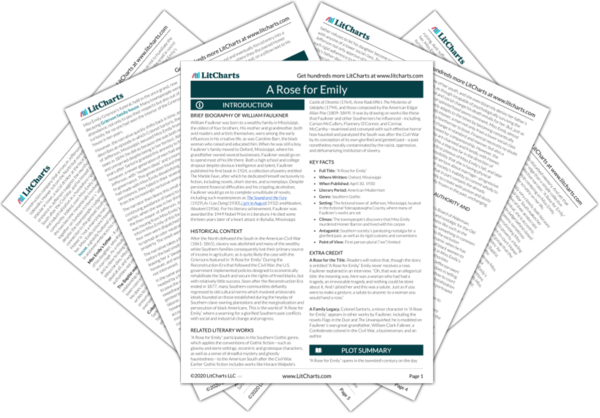“A Rose for Emily” is not a linear story, where the first event treated brings about the next, and so on—rather, it is nonlinear, jumping back and forth in time. However, there is a method to this temporal madness: the story opens with Miss Emily’s funeral, then goes back in time, slowly revealing the central events of Miss Emily’s life, before going back forward in time to the funeral. There, in the story’s final scene, the townspeople discover in Homer’s corpse and the strand of Miss Emily’s hair the facts that make sense of all the events described before—for example, that Miss Emily bought arsenic from the druggist while in her thirties not to commit suicide as the townspeople suspected, but rather to murder her defective sweetheart.
So, why does Faulkner structure his story like this? Toward the end of the story, its narrator makes a generalization about time that can be brought to bear on this question: for old people “all the past is not a diminishing road but, instead, a huge meadow which no winter ever quite touches, divided from them now by the narrow bottle-neck of the most recent decade of years.” Looked at in this light, doesn’t the non-linear nature of the story present the past it describes less as a “diminishing road” and more as a “meadow”, in which one might meander backward toward a glorified past? It is almost as if the townspeople’s nostalgia for the Old South, their desire to go back to a time they remember or mythologize as better, infects their storytelling practices. Perhaps—at least for now—it would be better if Jefferson got back onto the road of time, paved and lined with garages, and left their increasingly irrelevant social conventions in the dust. If only the past had been a diminishing road for Ms. Emily, rather than a huge rose-colored meadow where only corpses and the dust grow.
Time and Narrative ThemeTracker

Time and Narrative Quotes in A Rose for Emily
It [the Grierson family house] was a big, squarish frame house that had once been white, decorated with cupolas and spires and scrolled balconies in the heavily lightsome style of the seventies, set on what had once been our most select street But garages and cotton gins had encroached and obliterated even the august names of the neighborhood; only Miss Emily’s house was left, lifting its stubborn and coquettish decay above the cotton wagons and the gasoline pumps…

Unlock explanations and citation info for this and every other A Rose for Emily quote.
Plus so much more...
Get LitCharts A+She told them that her father was not dead. She did that for three days… We did not say she was crazy then. We believed she had to do that. We remembered all the young men her father had driven away, and we knew that with nothing left, she would have to cling to that which had robbed her, as people will.
…and the very old men—some in their brushed Confederate uniforms—on the porch and the lawn, talk[ed] of Miss Emily as if she had been a contemporary of theirs, believing that they had danced with her and courted her perhaps, confusing time with its mathematical progression, as the old do, to whom all the past is not a diminishing road but, instead, a huge meadow which no winter ever quite touches, divided from them now by the narrow bottle-neck of the most recent decade of years.
For a long time we just stood there, looking down at the profound and fleshless grin. The body had apparently once lain in the attitude of an embrace, but now the long sleep that outlasts love, that conquers even the grimace of love, had cuckolded him.
Then we noticed that in the second pillow was the indentation of a head. One of us lifted something from it, and leaning forward, that faint and invisible dust dry and acrid in the nostrils, we saw a long strand of irony-gray hair.











